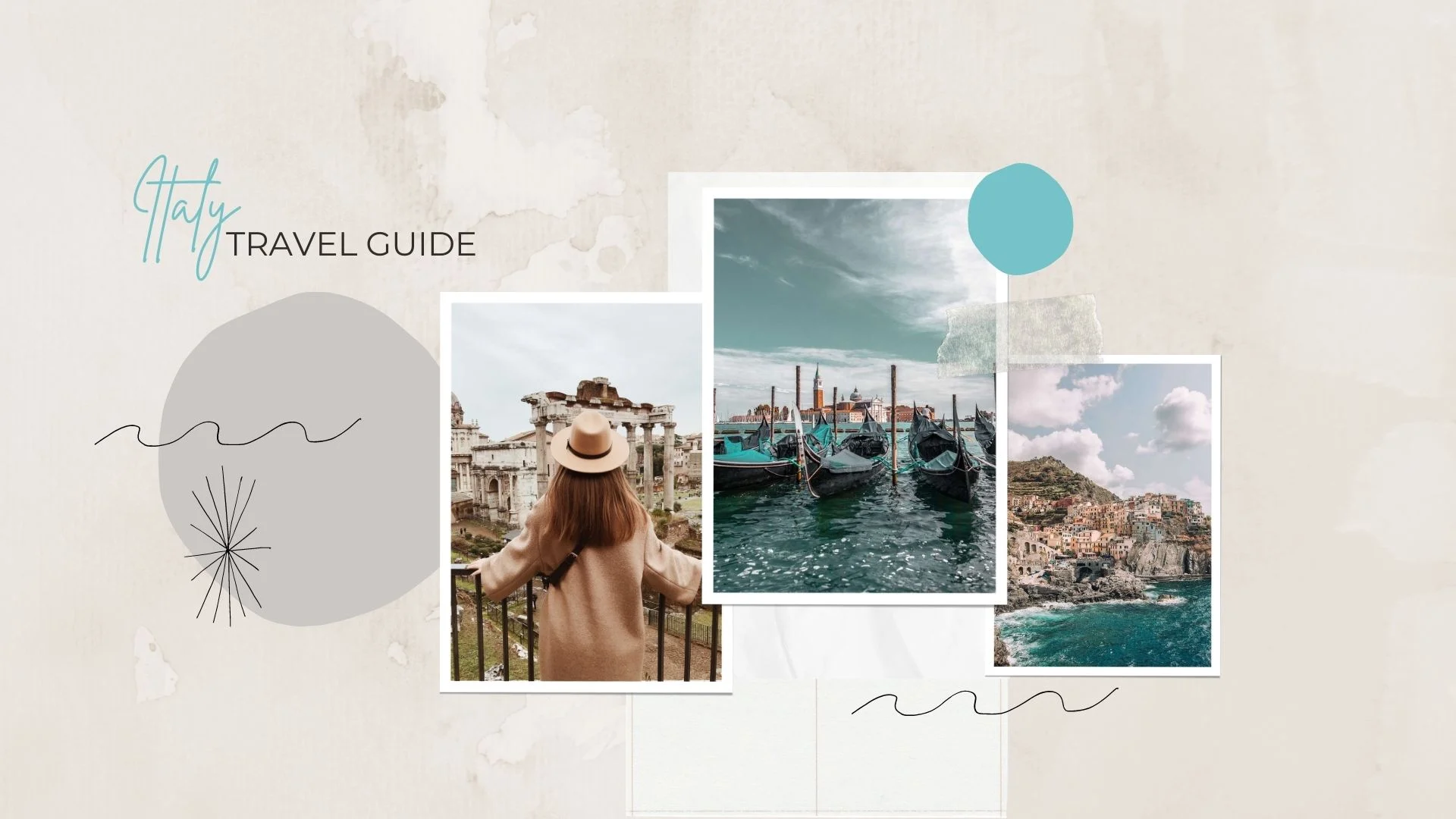I know I’m partial, but I’m in love with my country, and I’d like everyone to love it as much as I do. Hence this Italy travel guide, to help you discover Italy and everything it offers. Let’s start with some basics!
Italy travel guide (Italy 101 and Italy hidden gems)
Are you traveling to Italy for the first time?
Nothing beats tips from a local to get the best of your first trip to Italy. Most likely, you’ll want to focus on Italy’s top tourist attractions. Rome, Florence, and Venice are on every traveler’s dream list. Beautiful and unique, they’re an absolute must if you’re visiting Italy for the first time.
Rome, Florence, Venice: How long to stay in each of them?
If you can only spend one week in Italy, I suggest you stay three days in Rome, at least one day in Florence (better two), and no less than a day in Venice. The truth is that there’s so much to do and see in those cities that you could easily spend a week in Rome, three or four days in Florence, and two or three days in Venice.
For those able to stay 10 days in Italy or even two weeks, I suggest you visit some hidden gems and discover Italy off the beaten path. In some cases, you can have day trips from either Rome, Florence, and Venice or travel to some other Italian destinations.
Read also:
→ Traveling to Italy for the First Time? 10 Insider Tips for a Unique Trip
→ Fun Facts About Italy: Interesting Things You May Not Know
Italy bucket list
Italy for returning visitors
Once you’ve discovered the beauty of Italy, it’s hard not to come back. Actually, there are so many magical places in Italy that an entire life wouldn’t be enough to visit them all. Of course, there’s no reason not to go back to Rome, Florence, and Venice. I never get tired of these amazing cities. However, suppose you’ve already visited the top landmarks in Italy and wish to discover Italy’s hidden gems. In that case, there’s an abundance of destinations and experiences to choose from.
Unusual places in Italy for returning visitors

Planning a trip to Italy: Practical information
Currency: Euro
Time: GMT+1
Language: Italian is the local language. However, many Italians now speak English (although at different levels), especially in tourist spots. In the Dolomites and northern Lake Garda, German is relatively commonplace due to the proximity to Austria and a longstanding tradition of income from Germany.
Geography: Italy is located in southern Europe. The country is typically shaped like a boot, long and narrow, stretching from north to south. A relevant portion of Italy is covered by mountains. In the north, the Alps range from west to east. The Apennines cover a good amount of Italy along the north-south axis. As a peninsula, Italy vastly expands in the Mediterranean Sea, and most of its territory is surrounded by water.
Safety in Italy: Italy is generally safe, also for females traveling solo. The most important thing is to carefully watch your belongings to avoid pickpocketing. I generally avoid taking everything in the same place, storing cards somewhere else. I also often leave my passport where I’m staying and bring a photocopy. An infinity scarf is an excellent accessory to keep your valuables safe while maintaining a fashionable touch.
Payments, ATMs, and credit cards: ATMs are widespread, and withdrawing money is extremely easy. Payments by credit and debit cards are widely accepted, even for small purchases. The only exception is American Express Cards, which some vendors reject because of the higher commissions. Thus, you won’t usually need much cash.
Electricity and plugs: Plugs in Italy are type C/ F/ L. The voltage is 230V, and the frequency 50Hz. Especially if you’re traveling to Italy from overseas, you’ll need a universal plug adapter. Furthermore, you’ll need a converter if you’re bringing with you personal electric items like a shaver, toothbrush, curler, hairdryer, and battery chargers at 110V/120V.
Opening times: They vary, sometimes significantly, between cities and smaller towns and between north and south. For example, shops are usually open from 10 am to 7 or 7:30 pm in the center of large cities and the main tourist destinations, including on Sundays. This is not the case, however, in smaller towns. In southern Italy, during summer, it’s pretty standard for shops to close between 1 pm and 4 or 5 pm because of the heat. As for restaurants, closing days are generally either on Sunday night, Mondays, and sometimes Tuesdays.

Best time to visit Italy
There’s no straight answer to that question since the best time to visit Italy depends very much on which region (or regions) you plan to see. You must also consider what kind of travel experience you’re looking for. Here’s an idea of the weather in Italy you can expect, season by season.
Italy in spring
Spring in Italy is the best time to visit most of the country. The blossoming trees and flowers make everything more colorful, days get longer, and the temperature is at its best. Warm, but not too warm.
Spring is the perfect season to explore southern Italy since summer can be scorching. To enjoy the mountains, better wait until mid-May or early June, especially at higher altitudes. Late spring in the Alps is an explosion of colors. Bright green pastures, white and pink blossoms, and multicolored wildflowers.
Expect Italy in spring to be more crowded, though, especially during the Easter holidays and weekends.
Spring in Italy: Inspiration
Italy landmarks: Florence, Venice, Rome, Cinque Terre, Lake District.
Southern Italy: Naples, Pompei, and Amalfi coast. Puglia, Sicily.
Italy in summer
Summer in Italy is beautiful but also a little trickier. If you envisage visiting Italy in the summer, you have to plan your trip slightly more carefully. There are several reasons for that.
Although things have changed over the last 20 years, most Italians go on holiday in August. In most holiday destinations in Italy, August, and often even July, is the high season. That means more people, significantly higher prices, and the need to book beforehand. That is true in beach resorts and the mountains, the Dolomites most of all.
There’s good news, though. As Italians reach holiday destinations, cities get more empty. Prices often drop, as well as the crowds.
Have you ever wondered why in the Mediterranean countries people use to have a siesta (a nap) in the afternoon? In many cases, it’s because of the heat. Thus, if you dream of visiting southern Italy, keep in mind that the temperatures can get scorching.
Summer in Italy: Inspiration
Italy landmarks: Florence, Venice, Rome.
Active travel: Dolomites (hiking, biking, canyoning, and more).
Italy in autumn
Like spring, autumn in Italy is a perfect season to visit many destinations. Temperatures are still mild, and many destinations are quieter. The only downside is that as you approach winter, days get shorter.
September and October are a great time to explore the south and the cities. In November, the weather is more unpredictable, although you can still enjoy warm sunny days. Fall in Italy is also the time of many local food and wine festivals called “sagre.” They’re an excellent opportunity to taste delicious specialties, mingle with Italians, and have fun. Furthermore, many festivals occur in delightful towns, letting you discover a little more of off-beat Italy.
Autumn in Italy: Inspiration
Italy landmarks: Florence, Venice, Rome, Cinque Terre, Lake district.
Southern Italy: Naples, Pompei, and Amalfi coast. Puglia, Sicily.
Active travel: Hiking the Way of St Francis.
Italy in winter
Winter in Italy is the perfect season to visit cities, which are usually less crowded. Except, of course, during the Christmas holidays. In Northern Italy, winter can be chilly, but the day temperatures are often enjoyable from Florence southwards. If you want to ski in the Alps or admire the white-blanketed mountains, winter is the season to go. I also love the sea off-season, especially the Ligurian coast, with its temperate climate.
Winter in Italy: Inspiration
Active travel: Skiing in the Dolomites
Shopping: Milan in January for sales in the fashion capital.

Italy: How to get around
If you’re having your first trip to Italy, chances are that you’ll focus on Italy’s top tourist attractions. A classic Italy itinerary for first-timers encompasses Rome, Florence, and Venice. High-speed trains connect these cities quickly and regularly, and I recommend getting around by train.
In case you want to explore Italy off the beaten path, renting a car will make things much easier. Beware, however, that driving in the cities is quite difficult. Aside from the Italian driving style, several cities have areas where only residents can circulate. My advice is to park the car outside of the historic center, and then discover the city using public transportation.
_____________
This post contains a few affiliate links to carefully selected products and services. That means that if you make a purchase, I get a small commission at no extra cost to you.



